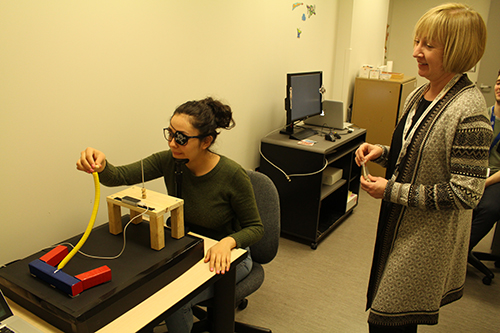Dr. Megan Levings and her team have recently published two papers on the very different functions and uses of regulatory T cells (Tregs). Tregs are immune cells that help to rein in immune responses to ensure that they don’t go too far and begin harming healthy tissues in their pursuit of foreign invaders.
Amblyopia, or lazy eye, affects about 100,000 Canadian children, but recent research suggests its definition may need to be updated.
Dr. Deborah Giaschi is investigating the reading ability of children with this vision development disorder, which has traditionally been considered an impairment of one eye. However, Dr. Giaschi said, it may be that this definition needs to be revisited.
Dr. Giaschi is an investigator at BC Children's Hospital, as well as a Language Sciences member and Professor of Ophthalmology & Visual Sciences at the University of British Columbia.
“We’ve been discovering the other eye is affected too. It’s not just one impaired eye. There are effects on everyday activities such as reading.”
This would change what the disorder is about, she said. If a disorder thought to affect vision in one eye turned out to have educational effects, this would be important, and is not something clinicians are currently trying to fix, Dr. Giaschi said.
“Clinically, it’s a one eye problem, it’s not considered a terribly blinding disease, but if it’s affecting things like reading ability, it matters.”
A recent study conducted by Dr. Giaschi and her laboratory at BC Children's Hospital, and published in Vision Research, found that four out of 14 children who had been treated for amblyopia performed below average on some of the tested reading tasks.
While the mean performance of both patient and control groups was within the normative range on all reading tests, meaning most children treated for amblyopia were performing on average compared with the general population, this finding is an important result because reading ability is crucial to success in life, Dr. Giaschi said. If any child were performing below average, the reasons needed to be examined, and appropriate supports provided. In addition, amblyopia does not seem to be associated with a single phenotype, she said, which is why it’s important to look at a range of skills in individual children.

The authors concluded that a prospective study on the effects of treatment of amblyopia on reading ability seemed warranted, given participants in the amblyopia group had received treatment; reading ability was not correlated with the degree of residual amblyopia; and the children with reading deficits had no or mild residual amblyopia.
While the study had a small sample size, it had controlled for amblyopia treatment, unlike previous studies, Dr. Giaschi said. In addition, no other study had assessed this particular set of English reading skills and evaluated them using standardized scores, the authors said. This allowed comparison of the control group with a large, general population, and assessment of whether children with amblyopia met requirements for reading supports in school.
The study also observed a correlation between motion perception and reading. This was related to the issue of whether standard amblyopia treatment (which involves placing a patch over the unimpaired eye) treats all visual issues, such as a deficit in motion perception or hand-eye coordination, rather than just visual acuity, or the ability to read an eye chart, the study said.
In addition, patching treatment fails to restore vision in about 30% of children, Dr. Giaschi said. Her team is currently working on creating risk profiles to help clinicians predict which children with amblyopia will have success with patching treatment and which other visual problems might occur. In a proposed collaboration with the University of Waterloo, a larger study would look at the correlation between motion perception and hand-eye coordination as part of this work, she said.
“The amblyopia clinical definition seems to need to be modernized. There may be different sub-types, [and an updated definition] would sort out how these sub-types would affect the effectiveness of treatment.”
Further study is needed to find out whether both eyes should be treated in children with amblyopia, Dr. Giaschi said. A current binocular treatment option being tested involves a 3D headset through which specially designed games, or altered movies, are played.
As well, future research should explore whether extra educational programs are needed for children treated for amblyopia, she said.
“It’s unlikely the treatment is causing reading effects. It’s more likely an inability of the treatment to treat the entire disorder.”
Credit UBC Language Sciences story, April 8, 2019.




